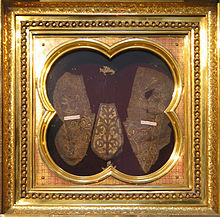Sandals of Christ
The sandals of Christ are among the most important relics of the Middle Ages. As Pippin III. Pope Stephen II. in Pippi's gift 754 the establishment of the Papal States agreed to some consideration of the church was preceded. Stephen's predecessor, Pope Zacharias , had recognized Pippin's election as king and in 752 gave him the relic of Christ's sandals .
Apart from its religious significance, the relic was the material embodiment of what the popes could offer the Frankish king: legitimation through the church .
The sandals were very useful to Pippin. He planned to upgrade the Prüm Abbey , a small monastery founded around 30 years earlier in the Eifel . So he left the abbey with huge property ( Prümer Urbar ) and also, again for legitimation, the relic. The abbey church of Prüm was then named Sankt Salvator (Holy Redeemer), and the monastery subsequently became the most important abbey and the home monastery of the Carolingians .
The possession of important relics was also a means of church policy. In order to compete with the powerful prince abbey, it was therefore necessary to present relics of similar provenance and quality. In the 12th century, the ambitious and power-seeking diocese of Trier reported the discovery of such an object: a robe of Christ, the so-called holy skirt . According to tradition, this came to Trier through St. Helena . As a biblically attested and theologically significant piece of clothing ( Joh 19,23-24 EU ) it was undoubtedly more impressive than the sandals.
It took another four centuries until Trier won the power struggle against Prüm. In 1524 the first great pilgrimage to the Holy Rock took place. In 1574 the Prüm Abbey lost its independence to Trier.
No particular veneration of the relics is recorded for the next two centuries, even if their existence was known. In 1794 they were brought to safety from the approaching revolutionary troops and reached Frankfurt, from where they returned to Prüm in 1810. In 1863, the Trier cathedral capitular Johann Nikolaus von Wilmowsky examined the relics, which at that time were in a presumably baroque box on the high altar of the former abbey church. He examined the pieces carefully, wrote a report and had them mounted on a board so that they could be accessed by the faithful. In 1896 the sandals were transferred to a new reliquary in the church choir. In the same year there was also a 14-day pilgrimage to the sandals; however, the wish of the pastor of Prüm at the time to make this a regular tradition was not fulfilled.
The sandals of Christ , more precisely: the remains of a richly decorated cloth shoe ( slipper ) from the Merovingian period (fifth to eighth centuries), according to other information from the Carolingian period, in which particles of the sandals of Christ were incorporated, are still in the Saint-Salvator today -Basilica can be seen in Prüm and are venerated there. They are on the north side of the choir of the church in the reliquary created in 1896, which is open on public holidays. They have lost the political significance they had in the Middle Ages, but their religious significance has remained.
literature
- Ludwig Petry (Hrsg.): Handbook of the historical sites of Germany . Volume 5: Rhineland-Palatinate and Saarland (= Kröner's pocket edition . Volume 275). Kröner, Stuttgart 1959, DNB 456882898 , p. 295 ( scan from the source ).
- St. Salvator's Basilica in Prüm was consecrated in 761 . In: Grenz-Echo . October 1, 2010 ( grenzecho.net (payment barrier) - newspaper article on the Prüm Abbey and the relic of the sandals of Christ).
Individual evidence
- ↑ Johann Nikolaus von Wilmowsky: Transfer of the relic of the sandals of the most holy Savior, and some other small relics of the church at Prüm from their older ones into their present reliquary container . In: Jacob Marx (ed.): The Salvatorkirche zu Prüm in its past and in its present . Self-rel. d. Salvatorkirche, Prüm 1863, p. 55–62 , urn : nbn: de: 0128-1-38362 .
- ↑ Robert Lürtzener: The Salvator Parish since 1802 . Kath. Pfarramt St. Salvator, Prüm 2002 (o. P.).
- ↑ Prüm's important relic: The sandals of Christ. August 6, 2012, accessed May 17, 2015 .
- ^ Fritz-Peter Linden: Pilgrims for Prüm? In: Volksfreund.de. July 30, 2012, accessed May 17, 2015 .
